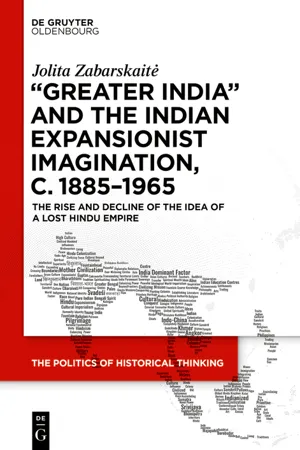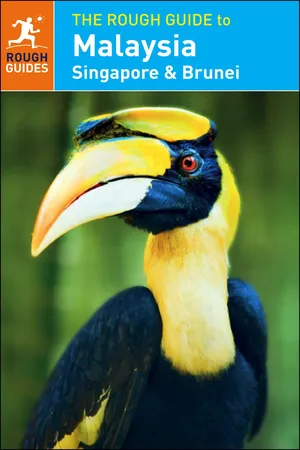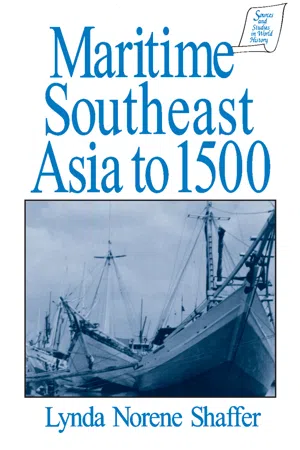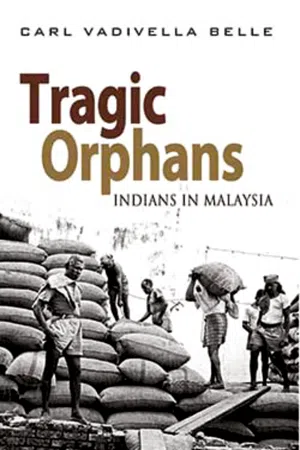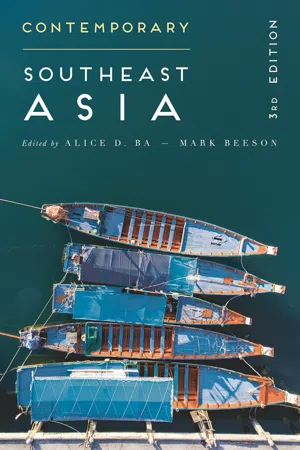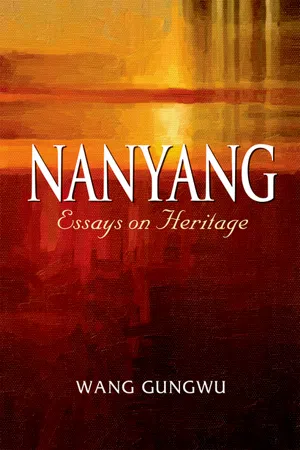History
Srivijaya Empire
Srivijaya Empire was a maritime and commercial kingdom that flourished in Southeast Asia from the 7th to 13th centuries. It was a powerful center for trade, controlling the strategic Malacca and Sunda straits. Srivijaya's influence extended across the Malay Peninsula, Sumatra, Java, and parts of Borneo, and it played a significant role in spreading Indian culture and Buddhism in the region.
Written by Perlego with AI-assistance
Related key terms
1 of 5
8 Key excerpts on "Srivijaya Empire"
- eBook - PDF
'Greater India' and the Indian Expansionist Imagination, c. 1885–1965
The Rise and Decline of the Idea of a Lost Hindu Empire
- Jolita Zabarskaitė(Author)
- 2022(Publication Date)
- De Gruyter Oldenbourg(Publisher)
The Srivijaya kingdom, which was established in Sumatra, was considered as a particularly powerful driver of expansion of trade and commerce, reaching India and China among others. The Srivijaya Empire, which was “essentially a great naval power, based on trade and commerce”, had reached its power and glory in the eleventh century by established a “hegemony over the western half of Java, Malaya, Kalimantan (Borneo), Sulawesi (Celebes), the Philippines, parts of Indo-China and Cambodia, half of Formosa, parts of Southern China round about Canton, Ceylon and some parts of India facing Ceylon, and probably the territory on the south-east coast of India including Negapatam”.177 This empire was known not only as a trading centre but also as “a centre of culture and learn- ing where pilgrims from China, on their way to India, used to stop”.178 Hence, this kingdom was known to India, and it even had support and upkeep from some vil- lages in Bihar to maintain “a Shrivijaya House at the famous Buddhist University of Nalanda”.179 Notwithstanding the reputation and prestige of Srivijaya, it was the empire of Majapahit which was framed as the foundation of an Indonesian unity under a single Indonesian government. Having been established on the island of Java, the Majapahit empire “grew rapidly at the expense of the neighbouring states” under the leadership of its prime minister Gajah Mada. According to the author, “Gajah Mada became Premier in 1331 and retained his office till his death in 1364. The Empire grew so powerful that it defeated the once most powerful Shrivijaya in 1377. Ultimately the entire Indonesian islands fell into the mighty 176 “An Indonesian History”, 395. 177 “An Indonesian History”, 395. 178 “An Indonesian History”, 395. 179 “An Indonesian History”, 395. - (Author)
- 0(Publication Date)
- Rough Guides(Publisher)
c.14th c. Srivijaya is challenged by the Majapahit empire of Java and declines CONTEXTS HISTORY 554 1511 The Portuguese capture Melaka Early 15th c. Paramesevara, a Srivijayan prince, establishes a kingdom at Melaka, which soon flourishes as a Muslim sultanate 15th c. The Brunei Sultanate rises to prominence, exercising power over most of northern Borneo For their part, the indigenous peoples acquired cloth, pottery, glass and absorbed the beliefs of those with whom they traded. From as early as 200 AD, Indian traders brought their Hindu and Buddhist practices, and archeological evidence from later periods, such as the tenth-century temples at Lembah Bujang (see p.159), suggests that the local population not only tolerated these new belief systems, but adapted them to suit their own experiences. Perhaps the most striking contemporary example of such cultural interchange is the traditional entertainment of wayang kulit (shadow plays), whose plots are drawn from the Hindu Ramayana . While trade with India developed very early, contact with China was initially less pronounced due to the pre-eminence of the Silk Road, further north. Only in the eighth and ninth centuries did Chinese ships first venture into the archipelago. By the time Srivijaya appeared on the scene, a number of states – particularly in the Kelantan and Terengganu areas of the Peninsula – were sending envoys to China. Srivijaya The inhabitants of the western Peninsula and eastern Sumatra were quick to realize the geographical advantage afforded by the Melaka Straits, which provided a refuge where ships could wait for several months for a change in the monsoon winds. From the fifth century onwards, a succession of entrepôts (storage ports) were created to cater for the needs of passing vessels.- eBook - ePub
- Lynda Norene Shaffer(Author)
- 2015(Publication Date)
- Routledge(Publisher)
K. Hall, 1985a : 83).Srivijaya and the Javanese Sailendras
Srivijaya’s success hinged on its location on an international trade route, its fine harbor, its silt-laden and navigable river, and the political and economic talents of its rulers, who subdued the pirates and promoted the region’s trade. But there was yet another important element in its success, a close relationship with their coreligionists, the Buddhist Sailendras, a royal lineage located in Central Java, well outside Srivijaya’s realm.Although Srivijaya’s agricultural resources were superior to those of any other port in the straits area, it is unlikely that its production was equal to the task of provisioning the ships and feeding international travelers, especially after the dramatic increase in traffic that occurred in the eighth century. Central Java was and is, however, the most productive agricultural region in the island realm. Srivijaya’s close relationship with the Sailendras may well have been based on a mutually beneficial exchange relationship that ensured Srivijaya’s access to some of Central Java’s crops. Thus, any picture of Srivijaya would be incomplete without a consideration of Central Java’s temple realm and Srivijaya’s relationship to it.1. Bas-relief carving of a sailing craft at Borobudur in Central Java, late eighth century. The ships carved on the Borobudur monument testify to the early development of Malay maritime technology. (Courtesy, H. Parker James.)2. A Jakarta harbor today. Although most of Indonesia’s cargo now moves on modern ships, sailing craft of traditional design are still in use. Dock workers were unloading lumber from the island of Kalimantan when this photo was taken. (Courtesy, Brady Hughes.)3. A Jakarta harbor today. A close look at the bows of sailing ships still in use reveals some similarities to the ships carved on the walls of Borobudur. (Courtesy, Brady Hughes.)4. - eBook - PDF
Tragic Orphans
Indians in Malaysia
- Carl Belle(Author)
- 2014(Publication Date)
- ISEAS Publishing(Publisher)
From the seventh century onwards, Srivijaya linked together most of the political units of the Melaka Strait, both in Sumatra and in the Malay Peninsula, in the process creating a broad accepted culture which incorporated language, institutions and an overlapping and interchangeable series of cultural forms. Leonard Andaya contends that an overarching sense of shared ethnicity originated in Southwest Sumatra and was later bequeathed to other parts of the region, most notably Melaka, Aceh and Johor. 30 Later developments in both China and India did much to promote trade in Southeast Asia. The Song Dynasty of China, founded in 960, adopted a much more aggressive trade policy. 31 Within India, the rise of the Chola Kingdom, which from 985 onwards had expanded from its core region on the Kaveri delta to control all of South India and much of Central India, as well as the offshore islands of Sri Lanka and the Maldives, fostered wide-ranging trade networks between Arabia and India, Southeast Asia and China. 32 Indeed, Chola kings took a personal interest in trade and, in addition to repealing harbour tolls and other imposts, encouraged trade missions and related maritime expeditions. 33 The establishment of maritime trade between Song China and Chola India not only involved the states of Southeast Asia as active participants, but also led to the decline of the land routes which had hitherto borne the bulk of East Asian–South Asian trade. 34 Trade between India and China also produced extensive diplomatic, cultural and religious exchanges between the two subcontinents and intensified Indian influences within Southeast Asia. 35 Early History, Melaka, and the Colonial Setting 5 Given the ostensibly close ties between the Chola kingdom and Srivijaya, it is thus surprising to discover that in 1017 and again in 1025 the South Indian king Rajendra Chola launched attacks on Srivijaya. - Derek Heng(Author)
- 2009(Publication Date)
- Ohio University Press(Publisher)
The appointment, which included the transfer of You are reading copyrighted material published by Ohio University Press/Swallow Press. Unauthorized posting, copying, or distributing of this work except as permitted under U.S. copyright law is illegal and injures the author and publisher. The Malay Region’s Diplomatic and Economic Interactions with China 97 five Chinese officials to assist the newly appointed Srivijayan foreign official, suggests that greater administrative responsibilities were at this point given to the Srivijayan representative to facilitate the flow of inter-national trade at Guangzhou, which came largely from Southeast Asia and the Indian Ocean littoral. Srivijaya’s commercial influence extended beyond the administra-tion of port activities, to affecting the shaping of mercantile shipping regulations. In matters pertaining to trade, Srivijaya had access to the state councillor in charge of Song China’s foreign affairs, who relayed the administrative dealings with Srivijaya and any requests made by Srivijaya to the Southern Song court. Srivijaya’s privileged access was unique among China’s trade partners. Presumably, Srivijaya’s trade with China was conducted predominantly under the auspices of its ruler, 73 and in that respect its conduct of trade was different from that of China’s other major trading partners—such as the Arabs, Java, Japan, and Korea—which was dependent on individuals and private commercial organizations, with little or no direct involvement by the political center. Thus, commercial dealings with Srivijaya were still regarded by the Southern Song court as intercourse between states, and appropriate attention and official access were made available accord-ingly. In 1144 , when the duty on fine products was raised to from 10 percent to 40 , foreign traders had complained to the mercantile ship-ping superintendency, but to no apparent avail.- eBook - PDF
Contemporary Southeast Asia
The Politics of Change, Contestation, and Adaptation
- Alice D. Ba, Mark Beeson, Alice D. Ba, Mark Beeson(Authors)
- 2017(Publication Date)
- Red Globe Press(Publisher)
The Malay cultural world developed on the shores of the Strait of Melaka, for more than two thousand years a choke-point on the trade route between India and China. Ports on the Strait provided an entrepôt for forest products from the interior of Sumatra. Java’s wealth in turn depended on the rich soils produced by its many volcanoes. Narrow but fertile valleys and coastal 18 Robert Cribb plains sustained not only rice but also ancient teak plantations, which pro-vided timber for Javanese vessels that penetrated the spice islands of eastern Indonesia and ranged across the South China Sea and the Bay of Bengal to the wealthy markets of China and India. In India and China, the conjoined plains of pairs of great rivers – the Indus and the Ganges, the Yellow River and the Yangzi – created space for a succession of great empires to emerge, and with those empires an enduring tradition of imperial ambition; Southeast Asia’s geography never sustained empire. Occasional long distance raids took place – Java to Cam-bodia and Sumatra, Burma to Siam, Mongols from the north, Cholas from India in the west – but these raids never led to enduring hegemonies across the region. Indeed, the only time in history that Southeast Asia has been politically united was the brief and exceptional Japanese occupation of the Second World War. Trade and cultural exchange linked Southeast Asia’s six civilizations, giving each of them important things in common with others, but political unity was absent. For as long as these civilization centres have existed, the Southeast Asian international order has been marked by another twenty or more smaller centres which have historically drifted in and out of subordination to one or other of the main civilizations. - eBook - PDF
- Anthony Milner(Author)
- 2009(Publication Date)
- Wiley-Blackwell(Publisher)
The Chinese people continued to value the luxury products, and to offer attractive items in return. Especially important in terms of Chinese influence is the likelihood that changes in imperial policy regarding trade were able to shape regional political dynamics. Oliver Wolters (1967) has suggested that in periods when the Chinese rulers sought to funnel trade through a single Archipelago centre – the Chinese saw this as tributary trade with a barbarian vassal – there were real opportunities for an ambitious local ruler to build an extensive empire. On the other hand, when the Chinese court allowed Chinese merchants to move freely around Southeast Asia, able to trade where they wished, polities which wished to free them-selves from such a hegemon were favoured: such polities were able to gain new material resources through direct trade with those merchants. Such an account of the ‘rhythm’ of the Archipelago certainly helps to explain the rise of Srivijaya, and then its long period of dominance from the seventh to the twelfth centuries – based on its continuing tributary relationship with China. It also throws light on Srivijayan decline, with the appearance later of an array of restless and ambitious polities. It is in the period when Chinese traders were moving around the region – beginning in the twelfth century – that we see the growing importance in the historical records of Early Histories: Engaging India and Islam 37 Aru, Tamiang, Kampe and Lamuri (all in the northern half of Sumatra). The later rise of Melaka on the other side of the Straits has been explained in terms of the expectation that the Chinese court would restore the tributary system. As Wolters pointed out, the “Ming victory, extending to southern China in 1368” raised expectations of the “restoration of the tributary system and the prohibition of Chinese voyages overseas” that had helped to undermine the authority of the Srivijaya hegemon. - eBook - PDF
Nanyang
Essays on Heritage
- Gungwu Wang(Author)
- 2018(Publication Date)
- ISEAS Publishing(Publisher)
12 It was not a coincidence that we both concentrated on maritime Southeast Asia. This was the easternmost part of the British Asia that Nick focused on. I, of course, was born and grew up in the middle of that Malay world. You may have noticed that I have used the word empire for very different kinds of states and that I was careful not to use its twin, the word imperialism. In fact, the definitions of empire are many because there have been so many empires in history but many of them could not be said to have been imperialist. Historians and political scientists have argued endlessly about what is common to all of them. For example, what do the ancient empires of India, China and Persia have in common with the modern British, Dutch and Japanese empires of the nineteenth and twentieth centuries? I shall come to that later. What about End of Empire 167 those empires in premodern Southeast Asia? The word empire has been used readily in our history texts today for the Angkor (or Zhenla-Khmer) and the Siamese empires on the mainland and Sri Vijaya, Majapahit and Malacca empires in the archipelago. One might add Vietnam moving south towards Cambodia if only because it is a reminder how elastic the term empire can be. There were empires to which other states paid tribute that also offered tribute to the larger Chinese empire. I must admit I knew little about the local imperial polities before I went to university. I should have known more about Malacca. It was the closest both in geography and in spirit to the state of Perak where I went to school, but most non-Malays of my generation knew less about that empire than about the Portuguese capture of its capital in 1511. It took me years to understand the significance of Malacca’s links with the empire of Sri Vijaya and its relations with the imperial states of Java, Siam and Ming China, and even longer to realize that, as empires, all these were very different from one another.
Index pages curate the most relevant extracts from our library of academic textbooks. They’ve been created using an in-house natural language model (NLM), each adding context and meaning to key research topics.
